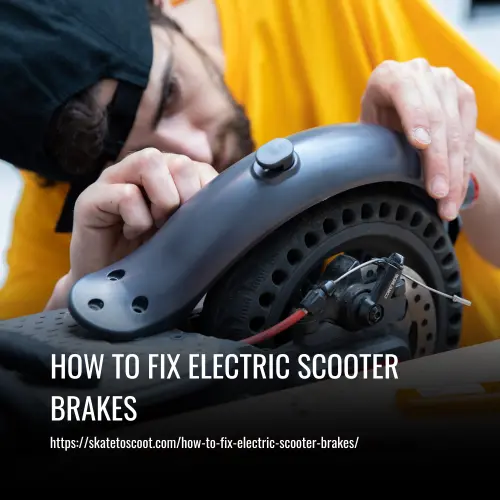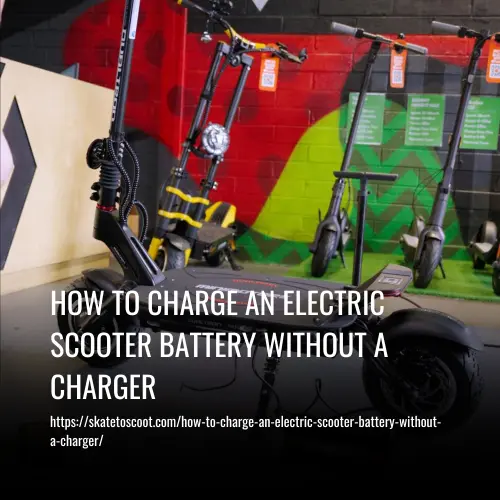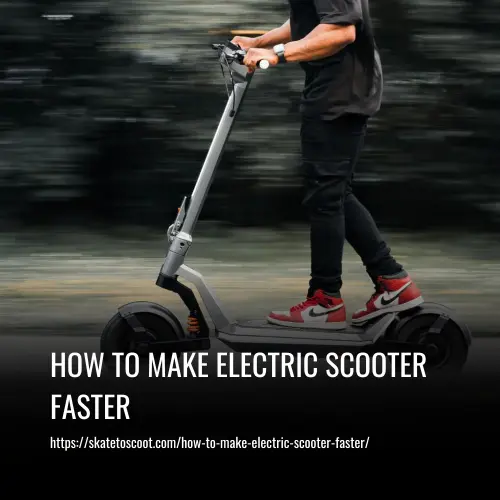As an Amazon Associate we earn from qualifying purchases.
The brakes on an electric scooter play a crucial role in ensuring rider safety and control. Over time, wear and tear can occur, causing them to become less effective. It is important to address any issues with the brakes promptly to avoid accidents and maintain efficient braking.
In this guide, we will explain the step-by-step process of fixing the brakes on your electric scooter. Whether you have mechanical disc brakes, regenerative brakes, drum brakes, or any other type, we’ll cover all the necessary steps to get your scooter back on the road.

How to Fix Electric Scooter Brakes: A Step-by-Step Guide
Maintaining the brakes on your electric scooter is crucial for safety and optimal performance. Whether you’re dealing with worn brake pads, loose cables, or other brake issues, here is a step-by-step guide on how to fix your electric scooter brakes.
1. Identify the Problem
Begin by diagnosing the problem with your electric scooter’s brakes. Common issues include worn brake pads, loose or disconnected cables, and problems with the brake caliper or disc. Identifying the specific issue will enable you to take appropriate corrective measures.
2. Gather Tools and Parts
Before starting the repair process, gather the necessary tools and parts. You will typically require a wrench, pliers, screwdriver, and the relevant replacement parts such as brake pads, cables, or calipers. Having everything handy will streamline the repair process.
3. Disconnect the Brake Cable
To access the brake cable, turn off your electric scooter and remove the brake lever from the handlebar by loosening the screw. Carefully disconnect the brake cable from the lever.
4. Inspect and Replace Brake Pads
Inspect the brake pads for signs of wear or damage, such as thinning or cracks. If necessary, replace the pads with new ones that are designed specifically for your scooter model. Properly fitting brake pads are essential for optimal performance.
5. Adjust or Replace Brake Cable
If the brake cable is loose or damaged, it will compromise your scooter’s braking efficiency. Adjust the tension or replace the cable completely. When reconnecting the cable to the brake lever, make sure it is securely fastened with the correct tension.
6. Inspect and Adjust the Brake Caliper and Disc
Thoroughly inspect the brake caliper and disc for any signs of wear, damage, or misalignment. If needed, adjust the caliper to ensure proper alignment with the disc, leading to efficient braking performance.
7. Test the Brakes
Before hitting the road, test your electric scooter’s brakes to ensure they are working correctly. Push the scooter gently while applying the brakes to check for a smooth stop. Additionally, test the brakes while riding at a slow speed.
8. Tighten Everything Up
Once you’ve confirmed that the brakes are functioning properly, double-check all components to ensure they are tightly secured. This includes the brake lever, cable, caliper, and brake disc.
By following these step-by-step instructions, you can effectively fix common electric scooter brake issues and ensure safe and efficient braking.
How to Adjust Disc Brakes on Electric Scooters
Adjusting the disc brakes on your electric scooter is an important maintenance task to ensure efficient braking performance and safety. Here we will provide you with a step-by-step process to help you adjust the disc brakes on your electric scooter.
1. Prepare the Electric Scooter for Adjustment
Before starting the adjustment process, place your electric scooter on a stable surface, such as a table or an elevated and flat area. Make sure the scooter is in an upright position for easier access to the brake components.
2. Identify the Problem
After preparing your scooter, turn it on and test the wheels. If you hear a rubbing noise or notice that the disc is touching the edges of the caliper, you need to adjust the brakes. This is a common issue with disc brakes and may require adjustment.
3. Slightly Loosen the Two Screws on the Caliper
Using an Allen wrench, gently loosen the top and bottom screws on the caliper. Only loosen them slightly, as a few twists per screw should be enough. This will allow you to move the caliper left and right to make the necessary adjustments.
4. Make Sure the Disc Doesn’t Touch the Caliper
Move the caliper accordingly, ensuring that the disc is centered and does not touch the edges of the caliper. Once you find the correct position, tighten the two screws while holding the caliper in place. If needed, ask for assistance to hold the caliper or tighten the screws.
5. Test the E-scooter
After tightening the screws, turn on the electric scooter and test the wheels again. If the caliper is properly positioned, you should no longer hear any rubbing noises. Additionally, test the brakes to ensure they are working well.
By following these steps, you can effectively adjust the disc brakes on your electric scooter and maintain optimal brake performance. Always prioritize safety when working with e-scooter components and make sure to turn off the scooter before making any adjustments.
How to Use Electric Scooter Brakes Effectively
Brakes are crucial for the safe operation of an electric scooter, but knowing how to use them effectively is equally important. By following these tips, you can optimize your electric scooter’s braking performance and enhance your riding experience.
1. Practice Good Riding Posture
Maintaining a proper riding posture is essential for better control of the scooter. By standing straight and balancing your weight evenly, you can achieve optimum comfort and stability. Make sure to position one foot on the deck of the scooter so that you can easily access the brakes when needed.
2. Control Your Speed
Riding at a controlled speed is key to effective braking. Excessive speed increases the risk of accidents and makes it more challenging to stop in time. By maintaining a steady pace, you provide yourself with a better chance to stop safely, especially in emergencies. Additionally, when descending a hill, keep a foot behind the brake for added security.
3. Use Your Feet on Uneven Ground
When encountering uneven or bumpy terrain, it is advisable to rely on your feet rather than solely depending on the brakes. By reducing your speed and using your feet to decelerate, you can mitigate the risks of skidding or losing control. This method is particularly useful for slippery or uneven surfaces where brakes alone may not provide sufficient grip.
FAQs
Electric scooters can have various types of brakes, including mechanical brakes, regenerative brakes, drum brakes, mechanical disc brakes, and hydraulic brakes. Each type has its own advantages and suitability for different riding conditions.
There are several reasons why electric scooter brakes may start to squeak. Some possible causes include new brake pads that haven’t fully settled, improper design leading to vibrations, contamination within the brakes, and alignment issues. If you notice squeaky brakes, contamination is a common culprit, which can occur on the brake pads, rotors, or wheel rims.
To fix squeaky electric scooter brakes, you can try cleaning the brake pads with a cloth or brush, replacing worn brake pads, or adjusting the brake caliper to ensure proper alignment. If the issue persists, it is recommended to consult the manufacturer or a professional for further assistance.
To fix electric scooter brakes, you will typically need tools such as an 8 mm open-ended wrench, a screwdriver, cable cutters, and a cable clamp. These tools are commonly used for brake adjustments, pad replacements, and overall maintenance.
Proper maintenance of electric scooter brakes is essential for optimal performance and safety. Regularly inspect the brake pads for signs of wear, check brake cable tension, and ensure the brake calipers are properly aligned. Additionally, keep the brake housing and cables clean and lubricate them as recommended by the manufacturer.
The most suitable brake for an electric scooter depends on factors like personal preference, riding style, and the scooter’s specifications. However, mechanical disc brakes are commonly regarded as efficient and reliable, providing good stopping power and suitable for various riding conditions.
The lifespan of an electric scooter brake can vary depending on factors such as the quality of the brake components, frequency of use, riding conditions, and maintenance. With regular maintenance and proper usage, electric scooter brakes can last anywhere from several months to a few years.
It is recommended to check your electric scooter brakes regularly, ideally every month or after every 100 miles of riding. This allows you to detect any signs of wear or damage early on and take necessary measures to address them.
Yes, it is possible to upgrade or replace your electric scooter brakes. However, it is important to ensure compatibility with your scooter model and consult the manufacturer’s guidelines or seek professional assistance if needed.
You should consider replacing your electric scooter brakes if you notice significant wear on the brake pads, excessive noise or vibrations during braking, reduced braking performance, or if the brake components are damaged beyond repair.
The cost of electric scooter brakes can vary depending on the brand, type, and quality of the brakes. On average, electric scooter brake pads can range from $10 to $30, while complete brake assemblies may cost between $30 to $100 or more, depending on the complexity and features.
Conclusion
In conclusion, properly maintaining and fixing the brakes on your electric scooter is essential for your safety and the scooter’s optimal performance. By following a step-by-step process, you can easily fix issues with the brake lever, brake pads, brake calipers, drum brakes, or mechanical disc brakes.
Regular maintenance, such as checking the brake cables, brake lines, and brake rotor for signs of wear, will help prevent any major issues. Adjusting the brake cable tension and ensuring the brake shoes are in their correct position will ensure efficient braking.
Amazon and the Amazon logo are trademarks of Amazon.com, Inc, or its affiliates.



